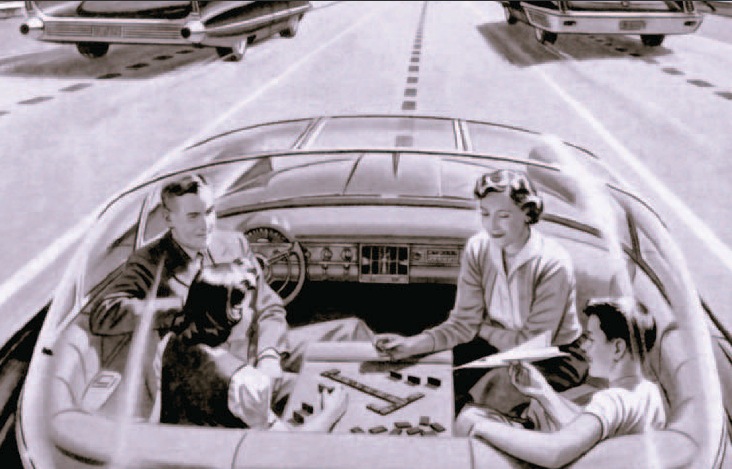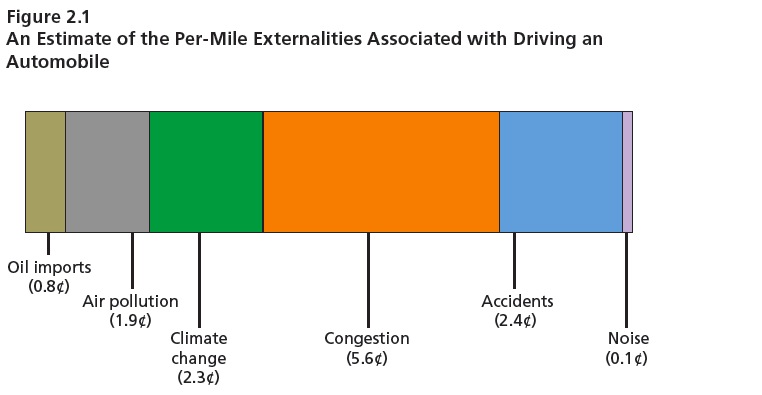RAND Corporation
 Autonomous vehicle (AV) technology offers the possibility of fundamentally changing transportation. Equipping cars and light vehicles with this technology will likely reduce crashes, energy consumption, and pollution—and reduce the costs of congestion.
Autonomous vehicle (AV) technology offers the possibility of fundamentally changing transportation. Equipping cars and light vehicles with this technology will likely reduce crashes, energy consumption, and pollution—and reduce the costs of congestion.
This technology is most easily conceptualized using a five-part continuum suggested by the National Highway Traffic Safety Administration (NHTSA), with different benefits of the technology realized at different levels of automation:
- Level 0: The human driver is in complete control of all functions of the car.
- Level 1: One function is automated.
- Level 2: More than one function is automated at the same time (e.g., steering and acceleration), but the driver must remain constantly attentive.
- Level 3: The driving functions are sufficiently automated that the driver can safely engage in other activities.
- Level 4: The car can drive itself without a human driver.
Careful policymaking will be necessary to maximize the social benefits that this technology will enable, while minimizing the disadvantages. Yet policymakers are only beginning to think about the challenges and opportunities this technology poses. The goal of this report is to assist policymakers at the state and federal levels to make wise policy decisions in this rapidly evolving area.
Promise and Perils of Autonomous Vehicle Technology
AV technology has the potential to substantially affect safety, congestion, energy use, and, ultimately, land use.
Conventional driving imposes not only costs borne by the driver (e.g., fuel, depreciation, insurance), but also substantial external costs, or “negative externalities,” on other people. For example, every additional driver increases congestion for all other drivers and increases the chance that another driver will have an accident. These externalities have been estimated at approximately 13 cents per mile. If a hypothetical driver drives 10,000 miles, she imposes $1,300 worth of costs on others, in addition to the costs she bears herself. AV technology has the potential to substantially reduce both the costs borne by the driver and these negative externalities, as we discuss below.
Effect on Crashes
While the frequency of crashes has been gradually declining in the United States, such incidents remain a major public health problem. There were more than 5.3 million automobile crashes in the United States in 2011, resulting in more than 2.2 million injuries and 32,000 fatalities, as well as billions of dollars in private and social costs. Worldwide, the figures are much higher.
AV technology can dramatically reduce the frequency of crashes. The Insurance Institute for Highway Safety (IIHS) estimated that if all vehicles had forward collision and lane departure warning systems, sideview (blind spot) assist, and adaptive headlights, nearly a third of crashes and fatalities could be prevented (IIHS, 2010). Automatic braking when the car detects an obstacle will also likely reduce a significant number of rear-end collisions. Technologies that permit the car to be primarily responsible for driving (Level 4) will likely further reduce crash statistics because driver error is responsible for a large proportion of crashes. This is particularly true given that 39 percent of the crash fatalities in 2011 involved alcohol use by one of the drivers. The overall social welfare benefits of vehicles that crash less frequently are significant, both for the United States and globally, and many of these benefits will go to those other purchasers of the autonomous vehicles.
Effect on Mobility
AV technology will also increase mobility for those who are currently unable or unwilling to drive. Level 4 AV technology, when the vehicle does not require a human driver, would enable transportation for the blind, disabled, or those too young to drive. The benefits for these groups would include independence, reduction in social isolation, and access to essential services. Some of these services are currently provided by mass transit or paratransit agencies, but each of these alternatives has significant disadvantages. Mass transit generally requires fixed routes that may not serve people where they live and work. Paratransit services are expensive because they require a trained, salaried, human driver. Since these costs are generally borne by taxpayers, substituting less expensive AVs for paratransit services has the potential to improve social welfare.
Effect on Traffic Congestion and Its Costs
AV technology of Level 3 or higher is likely to substantially reduce the cost of congestion, since occupants of vehicles could undertake other activities. These reductions to the costs of congestion will benefit individual AV operators. On the other hand, reductions or increases in congestion itself are externalities that will affect all road users. A decreased cost of driving may lead to an increase in overall vehicle miles traveled (VMT), potentially increasing actual congestion, but the technology can also enable increased throughput on roads because of more-efficient vehicle operation and reduced delays from crashes. Thus, the overall effect of AV technology on congestion is uncertain.
Land Use
As already noted, AV technology of Level 3 or above will likely decrease the cost of time in a car because the driver will be able to engage in alternative activities. Another effect of this may be to increase commuter willingness to travel longer distances to and from work. This might cause people to locate further from the urban core. Just as the rise of the automobile led to the emergence of suburbs and exurbs, so the introduction of AVs could lead to more dispersed and low-density patterns of land use surrounding metropolitan regions.
As already noted, AV technology of Level 3 or above will likely decrease the cost of time in a car because the driver will be able to engage in alternative activities. Another effect of this may be to increase commuter willingness to travel longer distances to and from work. This might cause people to locate further from the urban core. Just as the rise of the automobile led to the emergence of suburbs and exurbs, so the introduction of AVs could lead to more dispersed and low-density patterns of land use surrounding metropolitan regions.
AV technology may have different effects on land use in the developing world. Countries with limited existing vehicle infrastructure could “leapfrog” to AV technology. Just as mobile phones allowed developing countries to skip the development of expensive landline infrastructure, AV technology might permit countries to skip some aspects of conventional, human-driver centered travel infrastructure.
Download full version (PDF): Autonomous Vehicle Technology
About the RAND Corporation
www.rand.org
“The RAND Corporation is a nonprofit institution that helps improve policy and decision-making through research and analysis. RAND focuses on the issues that matter most such as health, education, national security, international affairs, law and business, the environment, and more. With a research staff consisting of some of the world’s preeminent minds, RAND has been expanding the boundaries of human knowledge for more than 60 years. As a nonpartisan organization, RAND is widely respected for operating independent of political and commercial pressures. Through our dedication to high-quality and objective research and analysis and with sophisticated analytical tools developed over many years, RAND engages clients to create knowledge, insight, information, options, and solutions that will be both effective and enduring.”







 RSS Feed
RSS Feed